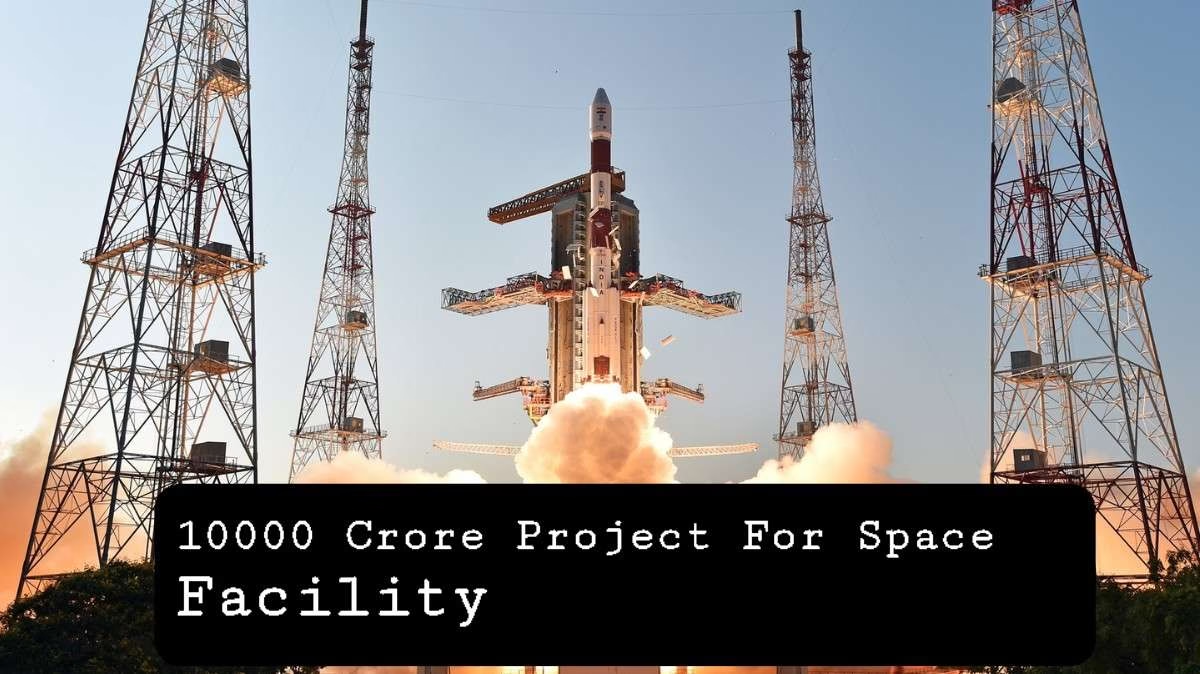Discover the truth behind ISRO’s ₹10,000 crore ISRO Gujarat space facility—what it is, what it’s not, and how it will shape India’s satellite and launch future.

ISRO’s ₹10,000 Crore Space Facility in Gujarat to Boost India’s Launch and Satellite Capabilities
India is preparing to expand its space infrastructure with a major new investment in Gujarat. While early reports referred to the project as a “space station,” officials have clarified that the upcoming ₹10,000 crore initiative is in fact a ground-based spaceport and satellite operations facility—not an orbital station. The facility will play a vital role in strengthening India’s launch, tracking, and satellite preparation capabilities.
The project is led by the Indian Space Research Organisation (ISRO) and is being developed by the Space Applications Centre (SAC) in Ahmedabad, Gujarat. The strategic location and scale of the facility underline ISRO’s commitment to building autonomous and globally competitive launch operations within Indian territory.
Clarification: ISRO Gujarat space facility Not an Orbital Space Station
Initial media reports mistakenly described the Gujarat facility as a “space station,” which typically refers to an orbital platform operating in Earth’s orbit, such as the International Space Station (ISS). However, ISRO SAC Director Nilesh Desai has clarified that the term was misinterpreted.
“This will be a ground-based spaceport and tracking facility, not a space station in orbit,” said Desai in a statement to regional media outlets.
The facility will include ground infrastructure for satellite assembly, pre-launch integration, and tracking, playing a critical support role for ISRO’s increasing frequency of satellite launches and missions.
Key Objectives of the ISRO Gujarat Space Facility
The new ISRO facility will serve as a multipurpose spaceport and operations center for a wide range of ISRO programs. Its core objectives include:
1. Launch Preparation and Satellite Integration
The site will feature advanced infrastructure to handle:
- Satellite assembly and testing
- Payload integration with launch vehicles
- Final mission readiness validation
2. Telemetry, Tracking, and Command (TTC)
The center will support tracking of:
- Launch vehicles in various flight stages
- Satellites in low-Earth and geostationary orbit
- Deep space missions including those to the Moon and Mars
3. Ground Control Operations
It will support real-time communication with satellites for data reception, maneuver coordination, and long-term mission control.
4. Research, Training, and Simulation
In collaboration with SAC and other ISRO units, the center will host training for mission controllers, simulate launch procedures, and support research into tracking technologies and signal processing.
Strategic Location in Gujarat: ISRO Gujarat space facility
Gujarat was chosen for this massive infrastructure project due to several strategic advantages:
- Proximity to ISRO’s Space Applications Centre (SAC) in Ahmedabad
- Strong regional support for high-tech industrial development
- Access to both inland and coastal logistics for transporting satellite components and launch hardware
The facility will also complement other ISRO centers like Sriharikota (Satish Dhawan Space Centre) and the upcoming second launch pad in Kulasekharapatnam, Tamil Nadu.
₹10,000 Crore Investment: A Boost to Space Infrastructure
The scale of investment—₹10,000 crore—reflects the growing demand for:
- High launch cadence due to India’s increasing satellite programs
- Self-reliant ground control systems with minimal foreign dependency
- Advanced testing capabilities for next-generation satellites, including communication, Earth observation, and navigation systems
This project will also support India’s ambition to send astronauts to space under the Gaganyaan mission, expected to launch in the near future. Ground support for such crewed missions is a critical component of national space preparedness.
A Major Step Toward Self-Reliant Space Operations
As ISRO scales up its activities—including missions to the Moon (Chandrayaan), Mars (Mangalyaan), and Venus, as well as commercial satellite launches—there is a clear need for robust, decentralized support infrastructure.
This Gujarat facility will:
- Reduce the load on existing ISRO centers
- Allow parallel launch preparations
- Provide mission redundancy in case of technical disruptions at other centers
- Help India compete in the global satellite launch services market
ISRO’s Broader Infrastructure Expansion: ISRO Gujarat space facility
The Gujarat spaceport is part of a broader plan by ISRO to build a resilient and distributed space infrastructure network across India. Other key projects include:
- New launch pad in Tamil Nadu
- Human Spaceflight Support Facility in Bengaluru
- Tracking and Data Reception Centers in Andaman and Lakshadweep Islands
- Space Situational Awareness (SSA) stations for orbital debris tracking
By expanding geographically, ISRO can offer quicker turnarounds between launches, better mission flexibility, and more control over orbital slot management—crucial for the growing Indian space economy.
India’s Growing Satellite and Launch Demand: ISRO Gujarat space facility
India currently operates a large fleet of satellites used for communication, navigation, weather monitoring, remote sensing, and defense. The government and private sectors are both seeing increased demand for satellite services. Key drivers include:
- Digital India and 5G connectivity
- Smart agriculture and disaster response
- National security and space-based surveillance
- Commercial satellite services and global partnerships
With the Indian space economy projected to grow to $40 billion by 2040, infrastructure like the Gujarat spaceport is essential to achieving these targets.
Support for Private Space Players
The facility will also benefit private companies working under the IN-SPACe (Indian National Space Promotion and Authorization Center) framework. This includes startups and established firms involved in:
- Satellite manufacturing
- Payload delivery
- Rocket testing
- Data analytics and Earth observation services
By providing access to government infrastructure, ISRO helps reduce the entry barrier for Indian private space firms and encourages technological innovation across the sector.
Local Economic and Educational Impact
In addition to national strategic goals, the project is expected to bring regional benefits to Gujarat, including:
- Creation of thousands of direct and indirect jobs
- Growth of aerospace-related industries and services
- Opportunities for local universities and students to participate in cutting-edge space research
Institutes in Gujarat may also gain access to new educational programs, internships, and partnerships with ISRO, encouraging a new generation of space scientists and engineers.
Conclusion: ISRO Gujarat space facility
The ₹10,000 crore space facility being developed by ISRO in Gujarat is not an orbital space station as initially reported but a critical ground-based center for space operations, satellite tracking, and mission support. Once operational, it will significantly strengthen India’s position in the global space sector and support the country’s growing ambitions in satellite services, deep space exploration, and human spaceflight.
This major investment is a step toward a self-reliant, scalable, and commercially competitive Indian space infrastructure, aligned with the government’s “Make in India” and “Atmanirbhar Bharat” initiatives.
As ISRO continues to push the boundaries of innovation, the Gujarat facility will play a key role in ensuring India remains at the forefront of global space exploration and technology.
ISRO Gujarat Space Facility: FAQs
Q1. What is ISRO building in Gujarat?
ISRO is developing a ₹10,000 crore ground-based space facility in Gujarat, which will function as a spaceport, tracking center, and satellite preparation hub. It is not an orbital space station.
Q2. Is ISRO building a space station in Gujarat?
No. ISRO clarified that the upcoming facility is not an orbital space station, but a ground-based infrastructure project meant for launch support, telemetry, and satellite operations.
Q3. What will the ISRO Gujarat space facility do?
The facility will support:
- Satellite assembly and testing
- Launch vehicle integration
- Real-time tracking and command (TTC)
- Ground communication and mission operations
Q4. Why is Gujarat chosen for this space project?
Gujarat offers strategic logistical advantages, proximity to ISRO’s Space Applications Centre in Ahmedabad, political support, and ideal land availability for the required infrastructure.
Q5. How much will the ISRO Gujarat space facility cost?
The total estimated investment is ₹10,000 crore, making it one of the largest ground infrastructure projects in India’s space history.
Q6. Will this facility support human spaceflight missions like Gaganyaan?
Yes, it is expected to provide mission tracking and ground support for upcoming crewed missions, including Gaganyaan, by offering redundant and advanced control systems.
Q7. How will this facility benefit the Indian space industry?
It will increase ISRO’s launch capabilities, reduce turnaround times, support private space startups under IN-SPACe, and help India become more self-reliant in space operations.
Q8. When will the ISRO Gujarat facility be operational?
As of now, no official completion date has been announced, but construction and planning are underway. The project is expected to become operational in phases over the next few years.
Q9. Will the general public have access to the spaceport?
Most of the facility will be secure and restricted to authorized personnel, but outreach and educational programs for students and researchers may be introduced in the future.

2 thoughts on “ISRO Gujarat Space Facility: What Is India’s ₹10,000 Cr Project At Ahmedabad?”